The Spatiotemporal Dynamics and Driving Factors of Ecosystem Services in Karst Geological Parks Under Tourism Development in China
Abstract
1. Introduction
2. Materials and Methods
2.1. Study Area
2.2. Data
2.3. Methods
2.3.1. ES Evaluations
2.3.2. Comprehensive ES Index Assessment
2.3.3. Identification of Influencing Factors Using GTWR
2.3.4. Impacts of Influencing Factors on ESs
3. Results
3.1. Comprehensive Ecosystem Service Index Assessment and Spatiotemporal Changes
3.2. Driving Forces of Changes in ESs
3.3. Spatial Heterogeneity of Tourism Impacts
3.4. Driving Pathways of Tourism Factors on ESs
4. Discussion
4.1. The Dual Effects of Tourism on ESs
- (1)
- Spatially differentiated measures such as zoning control and restrictions on development within core scenic areas;
- (2)
- Restorative interventions including vegetation recovery around hotel zones and the rehabilitation of degraded land;
- (3)
- The reinvestment of tourism-generated revenue into conservation programs to ensure long-term ecological sustainability.
4.2. Research Shortcomings and Limitations
5. Conclusions
- (1)
- Natural factors remain the dominant determinants of ES patterns; however, the influence of tourism has shown a clear and accelerating upward trend.
- (2)
- Tourism impacts exhibit pronounced spatiotemporal heterogeneity—persistent negative effects coexist with emerging positive outcomes across different landscape elements.
- (3)
- The primary mechanism through which tourism affects ESs operates indirectly via LUCC, thereby empirically validating and extending the theoretical “tourism–LUCC–ES” framework.
- (1)
- Implement spatial zoning strategies that strictly regulate construction in core scenic areas while promoting ecological restoration in degraded zones;
- (2)
- Establish an ecological compensation mechanism financed by tourism enterprises to support land rehabilitation;
- (3)
- Develop a multi-scale ecological monitoring and early warning system combining remote sensing data and on-site ecological indicators to identify the critical thresholds of ecosystem degradation.
Supplementary Materials
Author Contributions
Funding
Data Availability Statement
Acknowledgments
Conflicts of Interest
Abbreviations
| ESs | Ecosystem Services |
| UNESCO | United Nations Educational, Scientific, and Cultural Organization |
| POIs | Points of Interest |
| InVEST | Integrated Valuation of Ecosystem Services and Tradeoffs |
| GTWR | Geographically and Temporally Weighted Regression |
| BRTs | Boosted Regression Trees |
| SEM | Structural Equation Modeling |
| LUCC | Land Use and Land Cover Change |
References
- Ouyang, Z.; Zheng, H.; Xiao, Y.; Polasky, S.; Liu, J.; Xu, W.; Wang, Q.; Zhang, L.; Xiao, Y.; Rao, E.; et al. Improvements in ecosystem services from investments in natural capital. Science 2016, 352, 1455–1459. [Google Scholar] [CrossRef]
- Xue, H.; Li, S.; Chang, J. Combining ecosystem service relationships and DPSIR framework to manage multiple ecosystem services. Environ. Monit. Assess. 2015, 187, 117. [Google Scholar] [CrossRef]
- Xiong, S.; Yang, F.; Zhang, J.; Li, J.; Gu, C. Advancing multiscale sustainable development in lake-dense regions: A dynamic management chain for ecosystem service supply-demand and ecological risks interactions. J. Environ. Manag. 2025, 386, 125737. [Google Scholar] [CrossRef] [PubMed]
- Kubiszewski, I.; Costanza, R.; Anderson, S.; Sutton, P. The future value of ecosystem services: Global scenarios and national implications. Ecosyst. Serv. 2017, 26, 289–301. [Google Scholar] [CrossRef]
- Melese, W. Ecosystem Services and Tourism Potential in Lake Tana Peninsula: Ethiopia Review. J. Tour. Hosp. 2017, 6, 1–6. [Google Scholar]
- Costanza, R.; Kubiszewski, I.; Rasheed, R. Commentary: The Future of Changes in Global Ecosystem Services. Glob. Environ. Change-Hum. Policy Dimens. 2021, 71, 102399. [Google Scholar] [CrossRef]
- Costanza, R.; Farber, S. Introduction to the special issue on the dynamics and value of ecosystem services: Integrating economic and ecological perspectives. Ecol. Econ. 2002, 41, 367–373. [Google Scholar] [CrossRef]
- Andrew, C.; Tim, C.; Rob, F. Tourism in sub-global assessments of ecosystem services. J. Sustain. Tour. 2017, 25, 1529–1546. [Google Scholar] [CrossRef]
- Jasper, H.H.; Peter, G.; Frank, V. Using a social-ecological systems perspective to understand tourism and landscape interactions in coastal areas. J. Tour. Futures 2017, 3, 23–38. [Google Scholar]
- Shao, Y.; Xiao, Y.; Sang, W. Land use trade-offs and synergies based on temporal and spatial patterns of ecosystem services in South China. Ecol. Indic. 2022, 143, 109335. [Google Scholar] [CrossRef]
- Zeng, Y.; Zhong, L.; Wang, L. Spatiotemporal changes in recreation potential of ecosystem services in Sanjiangyuan, China. J. Spat. Sci. 2018, 63, 359–377. [Google Scholar] [CrossRef]
- Mita, D.; Lucia, B.; Daniel, D.; Menegon, S.; Pugnetti, A.; Stifter, S. Tackling challenges for Mediterranean sustainable coastal tourism: An ecosystem service perspective. Sci. Total Environ. 2018, 652, 1302–1317. [Google Scholar]
- Turner, K.G.; Anderson, S.; Gonzalez-Chang, M.; Costanza, R.; Courville, S.; Dalgaard, T.; Dominati, E.; Kubiszewski, I.; Ogilvy, S.; Porfirio, L.; et al. A review of methods, data, and models to assess changes in the value of ecosystem services from land degradation and restoration. Ecol. Model. 2016, 319, 190–207. [Google Scholar] [CrossRef]
- Zhou, Z.; Liu, X.; Zheng, B.; Robinson, G.M.; Song, B. Agricultural Transformation and Its Impact on Ecosystem Services and Human Well-Being in Peri-Urban Areas: The Case of Xi’an, China. Land 2022, 11, 110. [Google Scholar] [CrossRef]
- Li, Y.; Luo, Y.; Liu, G.; Ouyang, Z.; Zheng, H. Effects of land use change on ecosystem services: A case study in Miyun reservoir watershed. Acta Ecol. Sin. 2013, 33, 726–736. [Google Scholar] [CrossRef]
- Yuan, R.; Zhang, N.; Zhang, Q. The impact of habitat loss and fragmentation on biodiversity in global protected areas. Sci. Total Environ. 2024, 931, 173004. [Google Scholar] [CrossRef]
- Chiappero, M.F.; Rossetti, M.R.; Moreno, M.L.; Pérez-Harguindeguy, N. A global meta-analysis reveals a consistent reduction of soil fauna abundance and richness as a consequence of land use conversion. Sci. Total Environ. 2024, 946, 173822. [Google Scholar] [CrossRef]
- Lü, Y.; Ma, Z.; Zhao, Z.; Sun, F.; Fu, B. Effects of land use change on soil carbon storage and water consumption in an oasis-desert ecotone. Environ. Manag. 2014, 53, 1066–1076. [Google Scholar] [CrossRef]
- Yang, W.; Schmidt, C.; Wu, S.; Zhao, Z.; Li, R.; Wang, Z.; Wang, H.; Hua, P.; Krebs, P.; Zhang, J. Exacerbated anthropogenic water pollution under climate change and urbanization. Water Res. 2025, 280, 123449. [Google Scholar] [CrossRef] [PubMed]
- Hanna, D.E.; Raudsepp-Hearne, C.; Bennett, E.M. Effects of land use, cover, and protection on stream and riparian ecosystem services and biodiversity. Conserv. Biol. 2020, 34, 244–255. [Google Scholar] [CrossRef]
- Chi, W.; Zhao, Y.; Kuang, W.; He, H. Impacts of anthropogenic land use/cover changes on soil wind erosion in China. Sci. Total Environ. 2019, 668, 204–215. [Google Scholar] [CrossRef]
- Spake, R.; Lasseur, R.; Crouzat, E.; Bullock, J.M.; Lavorel, S.; Parks, K.E.; Schaafsma, M.; Bennett, E.M.; Maes, J.; Mulligan, M.; et al. Unpacking ecosystem service bundles: Towards predictive mapping of synergies and trade-offs between ecosystem services. Glob. Environ. Change-Hum. Policy Dimens. 2017, 47, 37–50. [Google Scholar] [CrossRef]
- Locatelli, B.; Imbach, P.; Wunder, S. Synergies and trade-offs between ecosystem services in Costa Rica. Environ. Conserv. 2014, 41, 27–36. [Google Scholar] [CrossRef]
- Bradford, J.B. Potential Influence of Forest Management on Regional Carbon Stocks: An Assessment of Alternative Scenarios in the Northern Lake States, USA. For. Sci. 2011, 57, 479–488. [Google Scholar] [CrossRef]
- McNally, C.G.; Uchida, E.; Gold, A.J. The effect of a protected area on the tradeoffs between short-run and long-run benefits from mangrove ecosystems. Proc. Natl. Acad. Sci. USA 2011, 108, 13945–13950. [Google Scholar] [CrossRef] [PubMed]
- Costanza, R.; Mitsch, W.; Day, J.W. A new vision for New Orleans and the Mississippi delta: Applying ecological economics and ecological engineering. Front. Ecol. Environ. 2006, 4, 465–472. [Google Scholar] [CrossRef]
- Li, Y.-J.; Ouyang, C.-X.; Zhou, S.-Y.; Yu, H.; Knight, W.D. Tourism dependence and poverty alleviation thresholds in Chinese ethnic tourism. J. Mt. Sci. 2022, 19, 3026–3036. [Google Scholar] [CrossRef]
- Wu, L.; Sun, C.; Fan, F. Estimating the Characteristic Spatiotemporal Variation in Habitat Quality Using the InVEST Model—A Case Study from Guangdong-Hong Kong-Macao Greater Bay Area. Remote Sens. 2021, 13, 1008. [Google Scholar] [CrossRef]
- Zhang, Y.; Pan, Y.; Li, M.; Wang, Z.; Wu, J.; Zhang, X.; Cao, Y. Impacts of human appropriation of net primary production on ecosystem regulating services in Tibet. Ecosyst. Serv. 2021, 47, 101231. [Google Scholar] [CrossRef]
- Li, Y.; Yao, S.; Jiang, H.; Wang, H.; Ran, Q.; Gao, X.; Ding, X.; Ge, D. Spatial-Temporal Evolution and Prediction of Carbon Storage: An Integrated Framework Based on the MOP-PLUS- InVEST Model and an Applied Case Study in Hangzhou, East China. Land 2022, 11, 2213. [Google Scholar] [CrossRef]
- Wu, J.; Jin, X.; Feng, Z.; Chen, T.; Wang, C.; Feng, D.; Lv, J. Relationship of Ecosystem Services in the Beijing-Tianjin-Hebei Region Based on the Production Possibility Frontier. Land 2021, 10, 881. [Google Scholar] [CrossRef]
- Gao, Y.; Song, Y.; Yang, L.; Hu, Y.; Hao, J.; Tian, J.; Li, Z. Revealing spatiotemporal heterogeneity of water conservation and its drivers: Enlightenment to water ecology protection and restoration. J. Environ. Manag. 2024, 370, 122517. [Google Scholar] [CrossRef]
- Li, Z.; Deng, X.; Jin, G.; Mohmmed, A.; Arowolo, A.O. Tradeoffs between agricultural production and ecosystem services: A case study in Zhangye, Northwest China. Sci. Total Environ. 2020, 707, 136032. [Google Scholar] [CrossRef]
- Adelisardou, F.; Jafari, H.R.; Malekmohammadi, B.; Minkina, T.; Zhao, W.; Karbassi, A. Impacts of land use and land cover change on the interactions among multiple soil-dependent ecosystem services (case study: Jiroft plain, Iran). Environ. Geochem. Health 2021, 43, 3977–3996. [Google Scholar] [CrossRef] [PubMed]
- Benez-Secanho, F.J.; Dwivedi, P. Analyzing the provision of ecosystem services by conservation easements and other protected and non-protected areas in the Upper Chattahoochee Watershed. Sci. Total Environ. 2020, 717, 137218. [Google Scholar] [CrossRef]
- He, Q.; Bertness, M.D.; Bruno, J.F.; Li, B.; Chen, G.; Coverdale, T.C.; Altieri, A.H.; Bai, J.; Sun, T.; Pennings, S.C.; et al. Economic development and coastal ecosystem change in China. Sci. Rep. 2014, 4, 5995. [Google Scholar] [CrossRef] [PubMed] [PubMed Central]
- Tian, Y.; Wang, S.; Bai, X.; Luo, G.; Xu, Y. Trade-offs among ecosystem services in a typical Karst watershed, SW China. Sci. Total Environ. 2016, 566, 1297–1308. [Google Scholar] [CrossRef]
- Wang, H.; Wang, W.J.; Liu, Z.; Wang, L.; Zhang, W.; Zou, Y.; Jiang, M. Combined effects of multi-land use decisions and climate change on water-related ecosystem services in Northeast China. J. Environ. Manag. 2022, 315, 115131. [Google Scholar] [CrossRef]
- Adelisardou, F.; Mederly, P.; Minkina, T. Assessment of soil- and water-related ecosystem services with coupling the factors of climate and land-use change (Example of the Nitra region, Slovakia). Environ. Geochem. Health 2023, 45, 6605–6620. [Google Scholar] [CrossRef]
- Deng, C.; Liu, J.; Liu, Y.; Li, Z.; Nie, X.; Hu, X.; Wang, L.; Zhang, Y.; Zhang, G.; Zhu, D.; et al. Spatiotemporal dislocation of urbanization and ecological construction increased the ecosystem service supply and demand imbalance. J. Environ. Manag. 2021, 288, 112478. [Google Scholar] [CrossRef] [PubMed]
- Seppelt, R.; Lautenbach, S.; Volk, M. Identifying trade-offs between ecosystem services, land use, and biodiversity: A plea for combining scenario analysis and optimization on different spatial scales. Curr. Opin. Environ. Sustain. 2013, 5, 458–463. [Google Scholar] [CrossRef]
- Das, B.; Desai, S.; Daripa, A.; Anand, G.C.; Kumar, U.; Khalkho, D.; Thangavel, V.; Kumar, N.; Reddy, G.P.O.; Kumar, P. Land degradation vulnerability mapping in a west coast river basin of India using analytical hierarchy process combined machine learning models. Environ. Sci. Pollut. Res. Int. 2023, 30, 83975–83990. [Google Scholar] [CrossRef]
- Bin, L.; Xu, K.; Pan, H.; Zhuang, Y.; Shen, R. Urban flood risk assessment characterizing the relationship among hazard, exposure, and vulnerability. Environ. Sci. Pollut. Res. Int. 2023, 30, 86463–86477. [Google Scholar] [CrossRef]
- Ding, Y.R.; Liu, X.; Dai, X.F.; Yang, Y.; Yin, G.Y.; Sun, H.P.; Guo, J.Y. Spatiotemporal analysis of sea ice in the Weddell Sea of Antarctic based on GTWR. Sci. Rep. 2025, 15, 5863. [Google Scholar] [CrossRef] [PubMed]
- Wang, H.; Zhao, M.; Huang, X.; Song, X.; Cai, B.; Tang, R.; Sun, J.; Han, Z.; Yang, J.; Liu, Y.; et al. Improving prediction of soil heavy metal(loid) concentration by developing a combined Co-kriging and geographically and temporally weighted regression (GTWR) model. J. Hazard. Mater. 2024, 468, 133745. [Google Scholar] [CrossRef] [PubMed]
- Li, J.; Auchincloss, A.H.; Yang, Y.; Rodriguez, D.A.; Sánchez, B.N. Neighborhood characteristics and transport walking: Exploring multiple pathways of influence using a structural equation modeling approach. J. Transp. Geogr. 2020, 85, 102703. [Google Scholar] [CrossRef]
- Cheong, Y.L.; Leitão, P.J.; Lakes, T. Assessment of land use factors associated with dengue cases in Malaysia using Boosted Regression Trees. Spat Spatiotemporal Epidemiol. 2014, 10, 75–84. [Google Scholar] [CrossRef]
- Lanzas, M.; Hermoso, V.; De-Miguel, S.; Bota, G.; Brotons, L. Designing a network of green infrastructure to enhance the conservation value of protected areas and maintain ecosystem services. Sci. Total Environ. 2019, 651 Pt 1, 541–550. [Google Scholar] [CrossRef] [PubMed]
- Pfueller, S.L.; Lee, D.; Laing, J. Tourism partnerships in protected areas: Exploring contributions to sustainability. Environ. Manag. 2011, 48, 734–749. [Google Scholar] [CrossRef]
- Carroll, C.; Ray, J.C. Maximizing the effectiveness of national commitments to protected area expansion for conserving biodiversity and ecosystem carbon under climate change. Glob. Chang. Biol. 2021, 27, 3395–3414. [Google Scholar] [CrossRef] [PubMed] [PubMed Central]
- Steibl, S.; Franke, J.; Laforsch, C. Tourism and urban development as drivers for invertebrate diversity loss on tropical islands. R. Soc. Open Sci. 2021, 8, 210411. [Google Scholar] [CrossRef] [PubMed] [PubMed Central]
- Rilov, G.; David, N.; Guy-Haim, T.; Golomb, D.; Arav, R.; Filin, S. Sea level rise can severely reduce biodiversity and community net production on rocky shores. Sci. Total Environ. 2021, 791, 148377. [Google Scholar] [CrossRef] [PubMed]
- Li, Y.; Cheng, D.; Adam, N.A.; Mirzalevens, S.; Zhang, G. Exploring the nexus between coastal tourism growth and eutrophication: Challenges for environmental management. Mar. Pollut. Bull. 2025, 216, 117922. [Google Scholar] [CrossRef]
- Li, L.; Feng, R.; Xi, J.; Huijbens, E.H.; Gao, Y. Distinguishing the impact of tourism development on ecosystem service trade-offs in ecological functional zone. J. Environ. Manag. 2023, 342, 118183. [Google Scholar] [CrossRef]
- Klotz, D.; Koppa, A.; Gao, H.; van Ogtrop, F.; van der Tol, C. A Global Assessment of Terrestrial Evapotranspiration Increase Due to Surface Water Area Change. Earth’s Future 2024, 12, e2024EF004802. [Google Scholar]
- Wang, K.; Chen, L.; Liu, H. Natural determinants of ecosystem services in karst regions: Implications for sustainable tourism development. J. Clean. Prod. 2023, 428, 139401. [Google Scholar]
- Ye, C.; Wang, S.; Wu, X.; Lee, T.M.; Wang, Y.; Wei, F.; Liu, Y.; Sun, B.; Yang, L. Targeted synergistic priorities for conserving biodiversity, carbon, and water on the Qinghai-Tibetan Plateau. Earth’s Future 2025, 13, e2024EF004802. [Google Scholar] [CrossRef]
- Pan, Z.; Gao, G.; Fu, B.; Liu, S.; Wang, J.; He, J.; Liu, D. Exploring the historical and future spatial interaction relationship between urbanization and ecosystem services in the Yangtze River Basin, China. J. Clean. Prod. 2023, 428, 139401. [Google Scholar] [CrossRef]
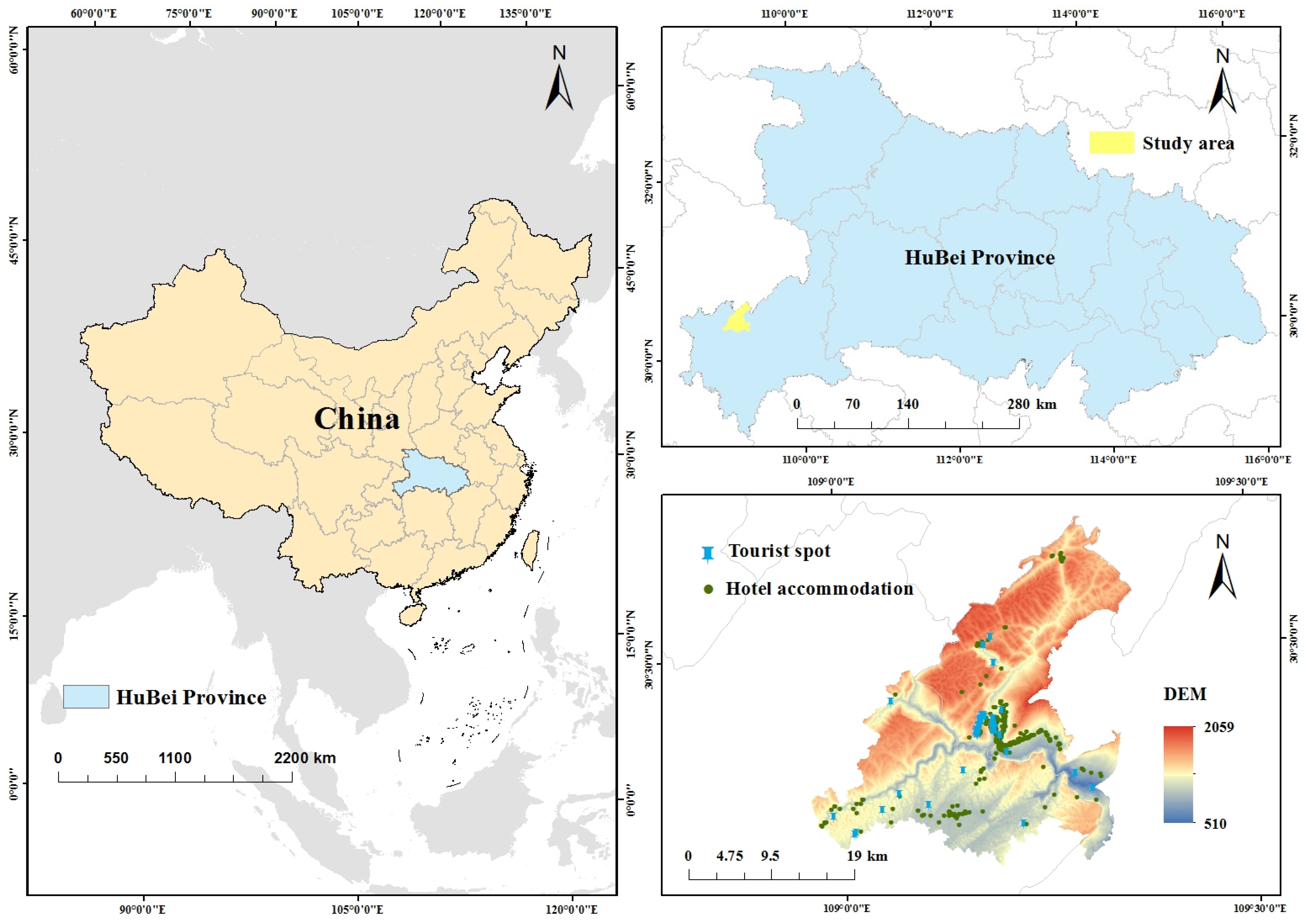
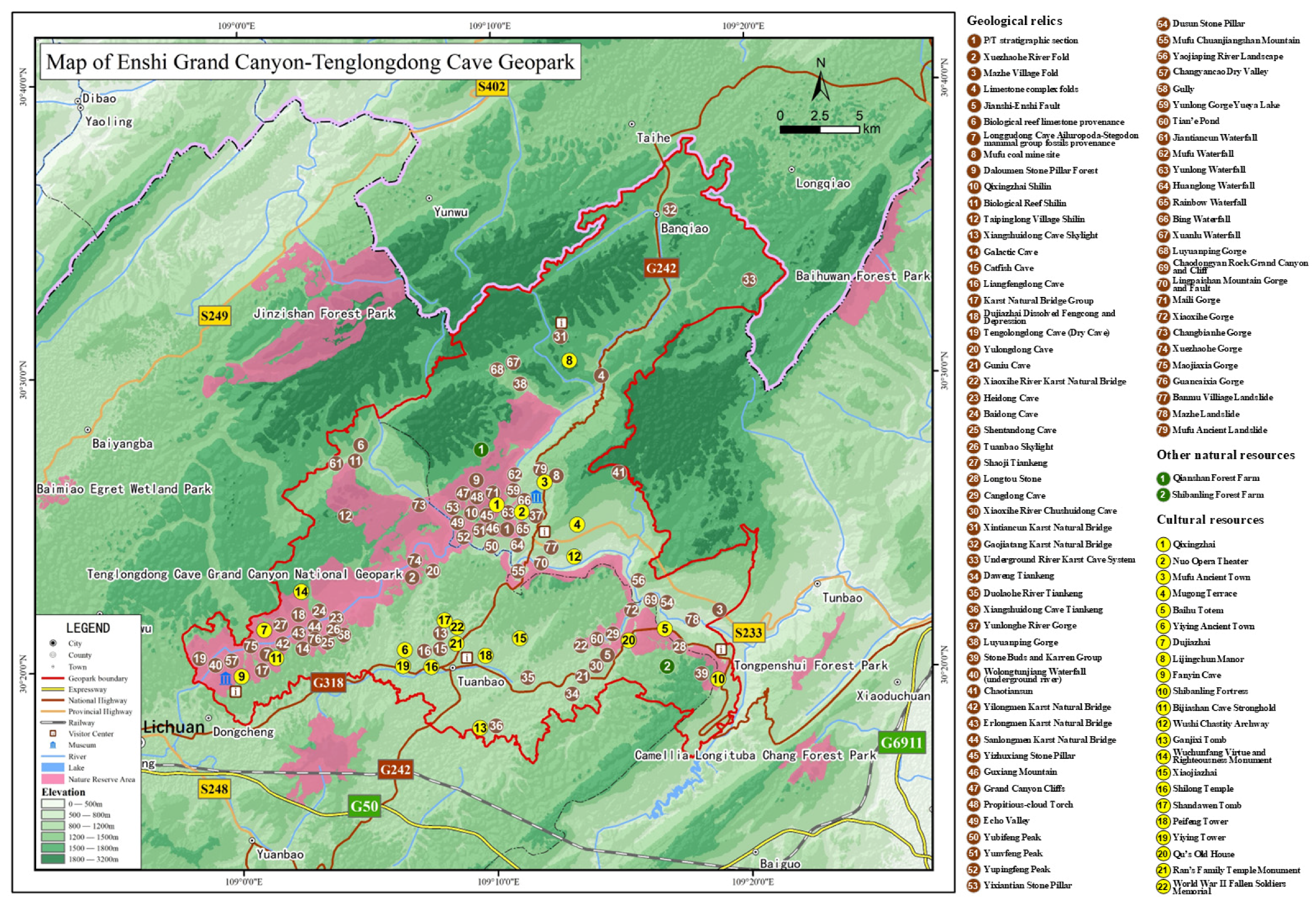


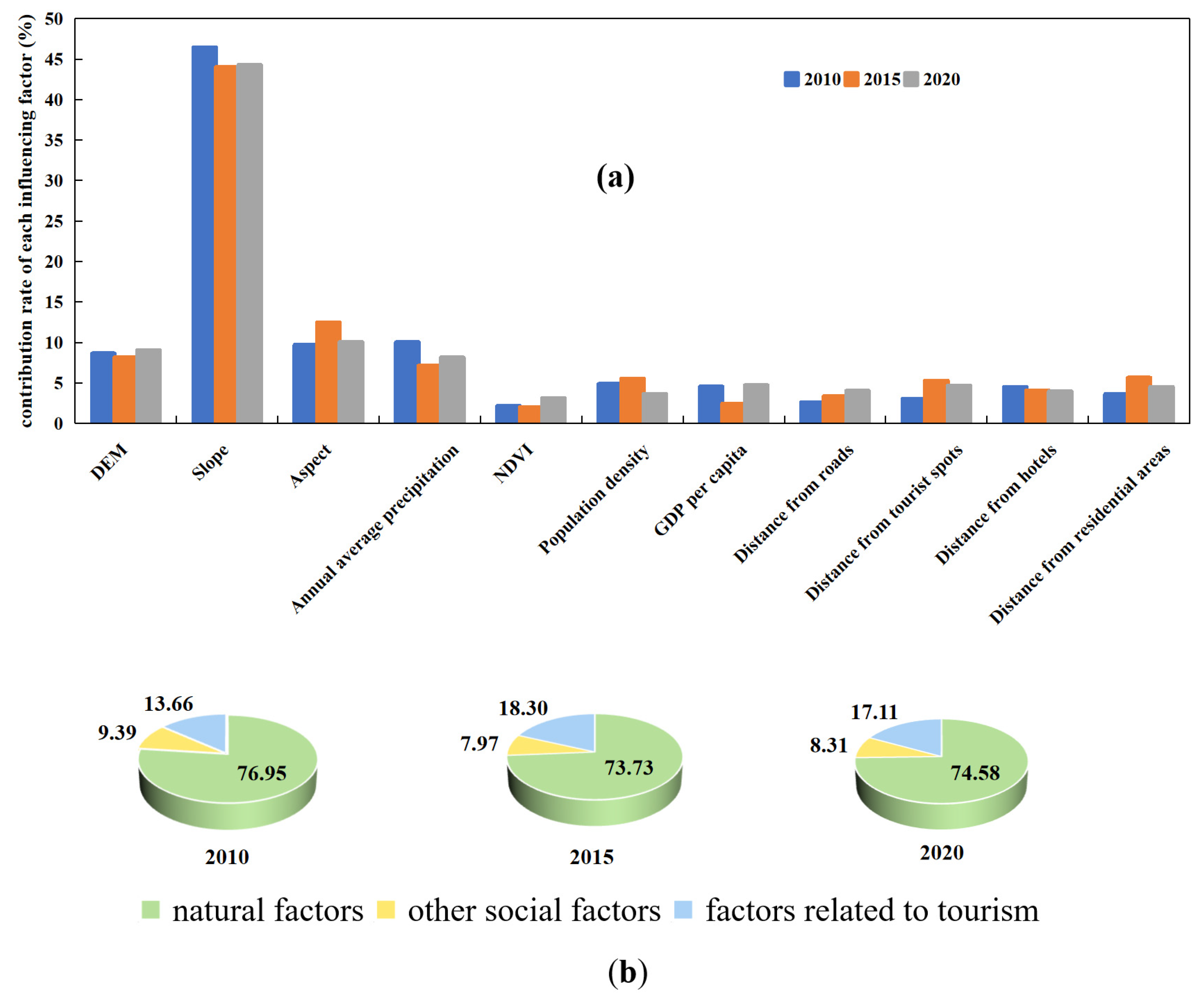
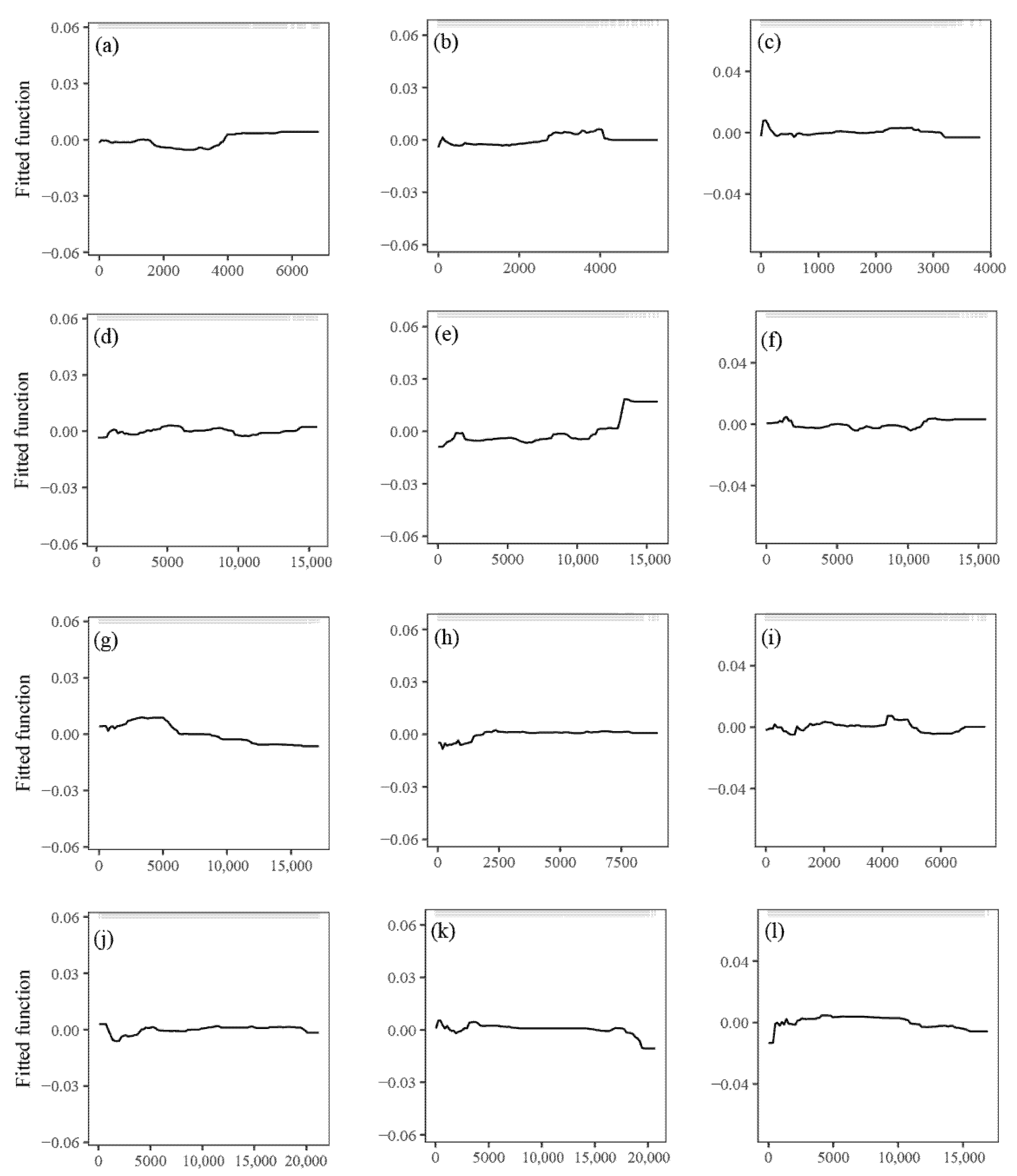
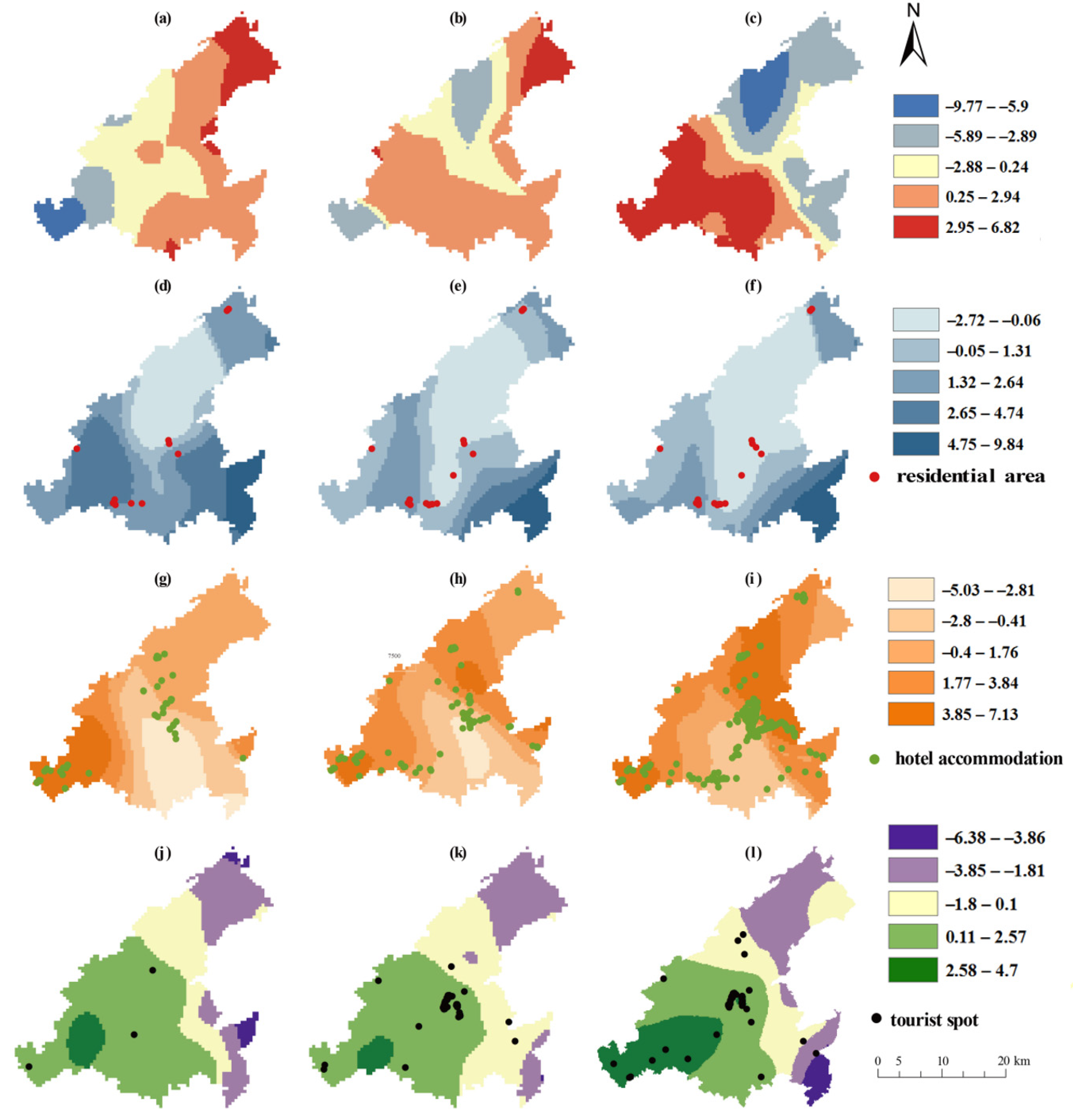
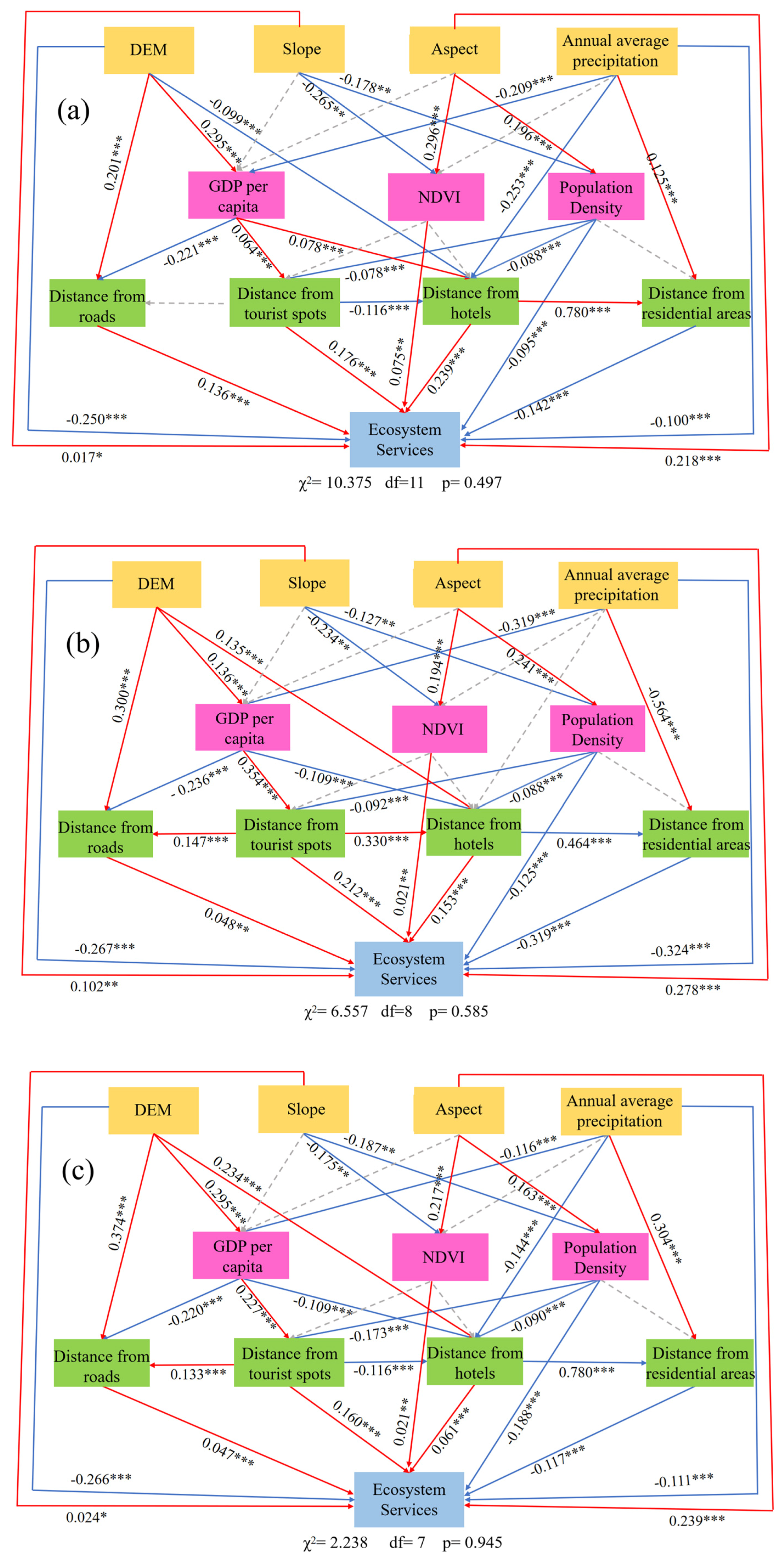
| Data | Resolution/m | Data Source | |
|---|---|---|---|
| Natural factors | Soil type | 1000 | Resource and Environmental Science Data Platform (https://www.resdc.cn/) (accessed on 21 August 2024) |
| Digital elevation model (DEM) | 30 | Geospatial Data Cloud (https://www.gscloud.cn/) (accessed on 12 May 2023) | |
| Normalized difference vegetation index (NDVI) | 500 | Resource and Environment Science Data Center(https://www.resdc.cn/) (accessed on 14 August 2024) | |
| Slope | 1000 | National Earth System Science Data Center http://www.geodata.cn (accessed on 18 May 2025) | |
| Aspect | 1000 | National Earth System Science Data Center http://www.geodata.cn (accessed on 18 May 2025) | |
| Temperature | 1000 | National Earth System Science Data Center http://www.geodata.cn (accessed on 18 May 2025) | |
| Precipitation | 1000 | National Earth System Science Data Center http://www.geodata.cn (accessed on 18 May 2025) | |
| Social and economic factors | Population density | 1000 | National Earth System Science Data Center http://www.geodata.cn (accessed on 27 May 2025) |
| GDP per capita | 1000 | National Earth System Science Data Center http://www.geodata.cn (accessed on 27 May 2025) | |
| Land use and land cover change (LUCC) | 30 | The 30 m annual land cover datasets and its dynamics in China from 1985 to 2023 (https://doi.org/10.5281/zenodo.12779975) (accessed on 12 March 2025) | |
| Tourism factors | Distance from roads | \ | Open street map (http://www.openstreetmap.org/) (accessed on 19 June 2024) |
| Distance from tourist spots | \ | Open street map (http://www.openstreetmap.org/) (accessed on 19 June 2024) | |
| Distance from hotels | \ | Open street map (http://www.openstreetmap.org/) (accessed on 26 June 2024) | |
| Distance from residential areas | \ | Open street map (http://www.openstreetmap.org/) (accessed on 26 June 2024) | |
| Ecosystem Service | Algorithm |
|---|---|
| Water Yield | where Y(x) is the annual water yield (mm) at grid cell x; AET(x) is the annual actual evapotranspiration (mm); and P(x) is the annual precipitation (mm) [32,33,34]. |
| Habitat Quality | where Dxj is the habitat degradation index of grid cell x in land cover type j; R is the number of threat factors; Yr is the number of grid cells of threat factor r; wr is the weight of threat factor r; ry is the stress value of grid cell y; irxy is the threat level of threat factor r in grid cell y to grid cell x; βx is the accessibility level of threat factors to grid cell x; Sjr is the sensitivity of land cover type j to threat factor r; Qxj is the habitat quality index of grid cell x in land cover type j; Hj is the habitat suitability index of land cover type j; z is a normalization constant (default value 2.5); and K is the half-saturation parameter (set to 0.5 in this study, typically half of the maximum habitat degradation value). The influence range of threat factors and the sensitivity of habitat types to threat factors were set with reference to [35]. |
| Soil Retention | SD = RKLS – USLE = R × K × LS × (1 – C × P) In the given formula, SD denotes the total annual soil retention (t·hm−2), RKLS refers to the potential soil erosion (t·hm−2), and USLE indicates the actual soil erosion (t·hm−2). R is the rainfall erosivity factor, K is the soil erodibility factor, and LS is the slope length–steepness factor. C represents the cover management factor, and P is the support practice factor. The parameterization of these factors (e.g., C and P) was conducted as described in Reference [36]. |
| Carbon Storage | where C is the annual carbon sequestration (t·hm−2); Ci-above is the aboveground biomass carbon density (t·hm−2) for land use type i; Ci-below is the belowground biomass carbon density (t·hm−2); Ci-soil is the soil organic carbon density (t·hm−2); and Ci-dead is the dead organic matter carbon density (t·hm−2). The carbon pool density values for each land cover type refer to [37]. |
| Scale | Signification |
|---|---|
| 1 | Indicates that one factor is of the same importance as the other. |
| 3 | Indicates that one factor is slightly more important compared to the other factor. |
| 5 | Indicates that one factor is significantly more important than the other when comparing two factors. |
| 7 | Indicates that one factor is more significant and important compared to the other factor. |
| 9 | Indicates that one factor is extremely more important than the other when comparing two factors. |
| 2, 4, 6, 8 | The median of the above two adjacent judgments. |
| count backwards | The judgment aij comparing factor i with factor j, then the judgment aij comparing factor j with factor . |
| R2 | RSS | AICc | |||
|---|---|---|---|---|---|
| GTWR | OLS | GTWR | OLS | GTWR | OLS |
| 0.57 | 0.43 | 4.61 | 5.65 | 704.25 | 843.67 |
| Year | Training Set Pearson Correlation Coefficient | Test Set Pearson Correlation Coefficient | R2 | RMSE |
|---|---|---|---|---|
| 2010 | 0.86 | 0.75 | 0.74 | 0.029 |
| 2015 | 0.86 | 0.77 | 0.73 | 0.028 |
| 2020 | 0.88 | 0.75 | 0.77 | 0.028 |
Disclaimer/Publisher’s Note: The statements, opinions and data contained in all publications are solely those of the individual author(s) and contributor(s) and not of MDPI and/or the editor(s). MDPI and/or the editor(s) disclaim responsibility for any injury to people or property resulting from any ideas, methods, instructions or products referred to in the content. |
© 2025 by the authors. Licensee MDPI, Basel, Switzerland. This article is an open access article distributed under the terms and conditions of the Creative Commons Attribution (CC BY) license (https://creativecommons.org/licenses/by/4.0/).
Share and Cite
Peng, J.; Zhang, Y.; Li, J.; Xu, X. The Spatiotemporal Dynamics and Driving Factors of Ecosystem Services in Karst Geological Parks Under Tourism Development in China. Land 2025, 14, 2262. https://doi.org/10.3390/land14112262
Peng J, Zhang Y, Li J, Xu X. The Spatiotemporal Dynamics and Driving Factors of Ecosystem Services in Karst Geological Parks Under Tourism Development in China. Land. 2025; 14(11):2262. https://doi.org/10.3390/land14112262
Chicago/Turabian StylePeng, Jing, Yuzhou Zhang, Jiangfeng Li, and Xiao Xu. 2025. "The Spatiotemporal Dynamics and Driving Factors of Ecosystem Services in Karst Geological Parks Under Tourism Development in China" Land 14, no. 11: 2262. https://doi.org/10.3390/land14112262
APA StylePeng, J., Zhang, Y., Li, J., & Xu, X. (2025). The Spatiotemporal Dynamics and Driving Factors of Ecosystem Services in Karst Geological Parks Under Tourism Development in China. Land, 14(11), 2262. https://doi.org/10.3390/land14112262





